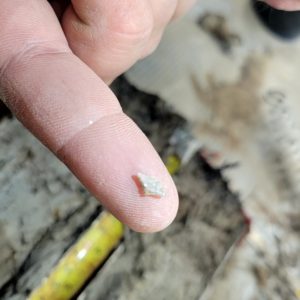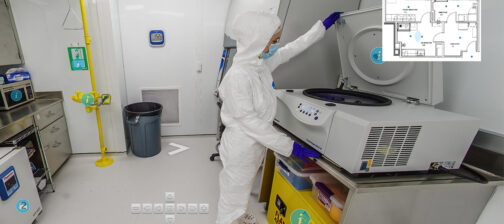
This past Wednesday, members of the Jamestown Rediscovery team joined Dr. Will Ouimet of the Department of Earth Sciences at the University of Connecticut (UConn) and Dr. David Leslie of TerraSearch Geophysical and Heritage Consultants. The project team opened vibracore samples collected in mid-October from the Pitch and Tar Swamp just north of James Fort. The work marks the beginning of a cross-disciplinary effort to understand relative sea level rise and anthropogenic (human influences) changes to the environment and sediments in the Jamestown area. This exciting new partnership will support undergraduate and graduate student research at UConn with hands-on experience on an exceptionally unique data set derived from one of the earliest European settlements in North America.
In May of 2022, the area was listed by the National Trust as one of the Nation’s 11 most endangered historic places. Facing an increasing frequency of inundation, the site of the first permanent English settlement in the New World will likely be completely submerged in the next century. Using the vibracore approach, the study the project team is conducting is a critical first step in understanding the geomorphology and how humans have interacted with the local environment of Jamestown for over 15,000 years.
Vibracoring is a way to reduce the frictional resistance and compressive disturbances when retrieving deep sediment cores. An aluminum barrel is attached to a concrete vibrating head, and driven over two meters into the ground. The cores are then vacuum sealed and taken off site to be opened and examined in detail in a lab. This method allows for several cores to be extracted with a small number of people, in a relatively low-tech, but high-reward method of removing soil stratigraphy from the field.

The work the project team is doing this week in the lab follows up on the field sample collection and involved splitting the core tube down the sides and separating the core into two equal halves. Once opened, a preliminary visual inspection of each sample was conducted to verify that the cores were successful and to inspect for potential artifacts and charcoal that may help date various stratigraphic layers within the core. A common artifact noted in nearly all the samples was fragments of brick; however, one sample did contain an exciting and somewhat unexpected find. About 16 in. (41 cm) into one of the cores, the project team noted the presence of a small quartzite flake. While an exceptionally rare find in vibracore sampling, the stone flake is strong evidence the submerged area where the sample was taken was once dry and occupied by Virginia Native Americans.
Following the preliminary inspection, one half of each core was then cleaned, frozen, and archived for future research. The half not archived will be photographed using an automated system (invented by Mark Smith a UConn alumni!) that gives the researcher an extremely high-resolution image of the sediment sample. Following the documentation, the stratigraphy is then mapped and described based on color, structure, and sediment type. Once the sediments are defined, the layers of soil undergo a range of analyses including geochemical, isotopic, and pollen testing. Over the next few months (and likely years), UConn students and the rest of the project team will examine the cores very closely, which will help to evaluate the Pitch and Tar Swamp and also determine a research path forward to study an important part of one of our Nation’s most important archaeological sites.
Minimally invasive survey techniques such as terrestrial vibracoring provide archaeologists with ways to assess the sedimentary environments prior to excavation. When paired with geophysical techniques such as ground-penetrating radar, this research can provide a wealth of information about an archaeological site and identify ideal locations for future excavations in submerged contexts thereby saving time and funding. This initial step toward a program of research undertaken collaboratively between the Jamestown Rediscovery Team, TerraSearch Geophysical, Heritage Consultants, and UConn demonstrates that there is considerable utility in this approach and no doubt many exciting archaeological finds to come!
Related Images
- Dr. David Leslie and undergraduate student Preston Senderoff remove portions of the aluminum tube holding the soil sample.
- Director of Archaeology David Givens, Preston Senderoff, and graduate student Stephanie Scialo inspect the sediment in the core sample.








